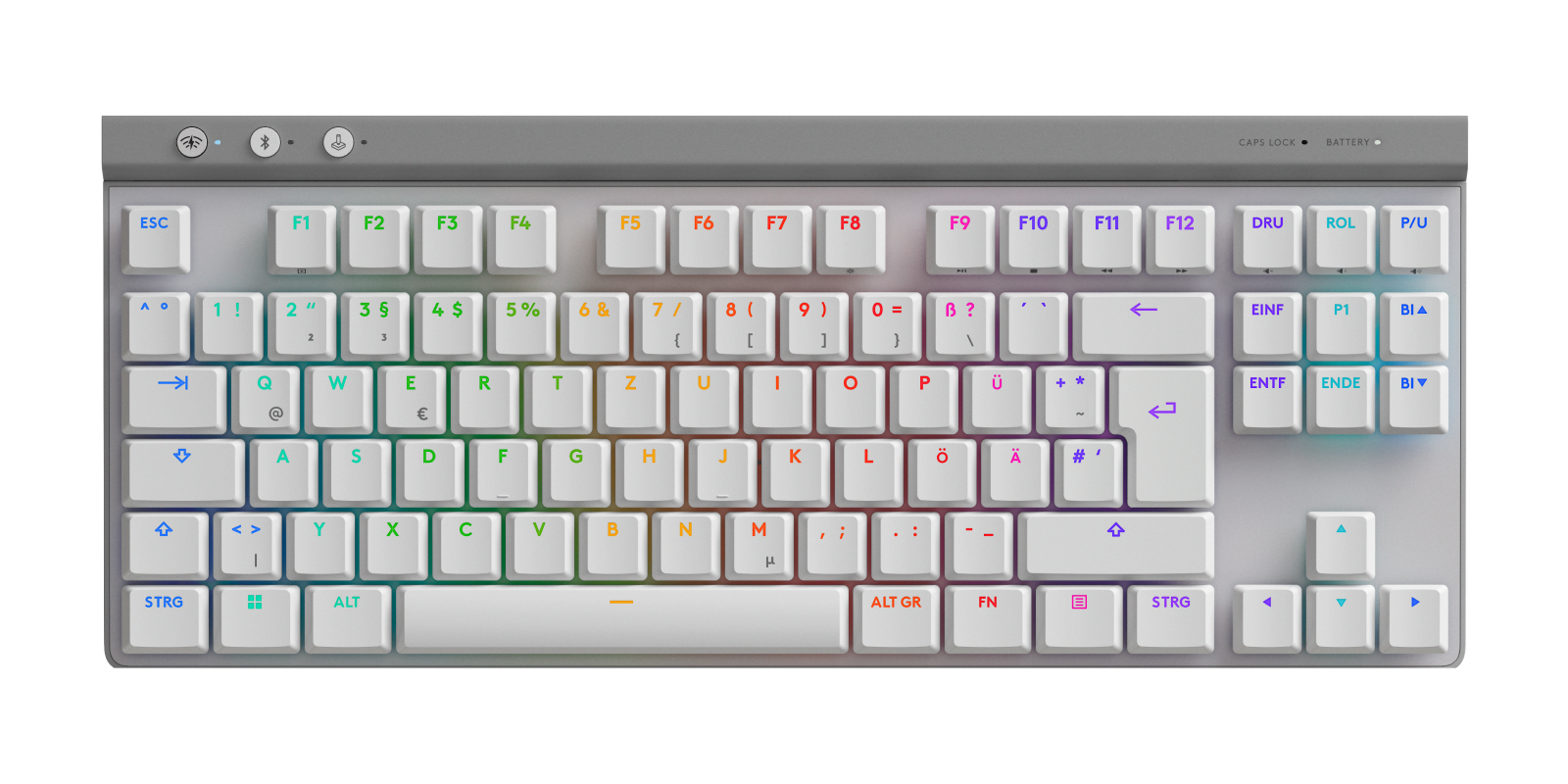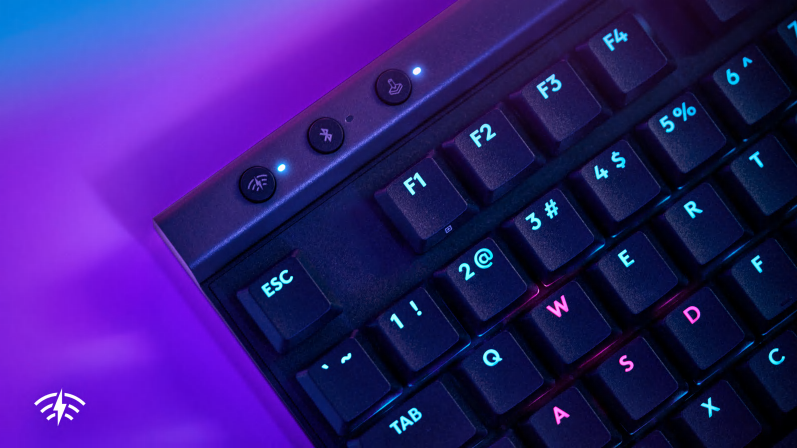Logitech G515 Lightspeed TKL Keyboard feels like a takedown of the G915 model. The aluminium body has been replaced by plastic, and various features like the volume dial have been removed. What remains is a low-profile keyboard that retains most of the features and still performs as well as the aforementioned G915, at a price that’s more friendly to your wallet.
Right out of the box, the first thing you notice is the weight: while the G515 Lightspeed TKL is made with a plastic body as opposed to the aluminium body of the G915, the G515 is actually heavier, tipping the scales at 880g (the G915 Lightspeed TKL comes in at 810g). But don’t let the number fool you, because the overall form of the G515 Lightspeed TKL Keyboard is sleek: while it lacks the aluminium body, the plastic body is subtle yet sturdy enough to not feel flimsy, and with the low-profile keys, the height of the keyboard comes at a vertically challenging 22mm at the lowest height setting. With the slightly two-tone colour scheme of the keyboard (mostly black with a steel grey top trim that houses the USB-C connection, power switch toggle, and mode select buttons), the G515 Lightspeed TKL will look dapper for any gamer that wants their setup to look… demure.

In terms of feel, the G515 Lightspeed TKL maintains the same double-shot PBT keycaps and GL mechanical switches that were present in the G915. An actuation distance of 1.3mm and an actuation force of 45g mean key presses are very responsive; a feathery touch is all that is needed for the keyboard to recognise input. Not only does this mean a textured key, which feels a lot more resistant and less likely to wear over time, but the brown low-profile switches also feel great; each key press is satisfying without the loud clicky sound that other mechanical switches make, if that is what you prefer. Under the plastic housing sits a layer of plastic foam that further dampens the clicking sound. This is really down to personal preference, but I prefer the brown switches’ subtle sounds over the clicky sounds of other mechanical switches while still maintaining the “thock” sound with each key press, so this keyboard, along with the low-profile keys, make for a wonderful combination of a muted typing experience.

While the typing experience is comfortable yet satisfying, I would have preferred the addition of a wrist support. While the low-profile keyboard did help put my hands in a relatively neutral position, it still put a bit of strain on my wrist, which I felt after a while.
Another missing physical feature that I would have loved to have is the volume wheel. While I can understand that the physical input would have most likely needed to be omitted in order to reduce the cost, the replacement solution of sharing the media and volume controls with some of the function keys doesn’t give the same tactile satisfaction as a smooth volume rocker present on the G915. Furthermore, there are also no dedicated physical keys for shortcuts or custom programming.
Moving onto latency, the G515 Lightspeed TKL Keyboard uses the Logitech Lightspeed receiver technology in the product’s namesake, which reduces latency to 1ms when you connect the keyboard via the Logitech G Lightspeed adapter dongle, making the keyboard extremely responsive. This comes in handy during gaming, when response time to the milliseconds is critical. The latency jumps up to 14ms when connected using the Bluetooth mode, but when I was in Bluetooth mode (during non-gaming applications), I honestly couldn’t notice the difference. Then again, who is noticing latency when writing reports?

On the software front, the G515 Lightspeed TKL Keyboard uses the Logitech G Hub to customise the RGB backlighting and the animation with a plethora of options. The G Shift functionality allows extra commands to be assigned to one key, and the game mode lets you disable certain keys when gaming to prevent unnecessary key presses. While the function of customising colours and keys is a nice-to-have feature, the G Hub software can be quite resource-intensive on your computer, contrasting the minimalist, inconspicuous nature of the physical keyboard.

The battery life of the Logitech G515 Lightspeed TKL Keyboard is advertised as 36 hours on the box (while the G Hub states 44 hours when fully charged), which seems like a long time, but compared to other keyboards that offer up to 90+ hours of use before recharging, it is comparatively low, especially considering the lithium-ion battery is what makes up the bulk of the keyboard’s weight. I did experience the keyboard’s battery life draining relatively quickly, but I could easily charge the keyboard using the included USB-C cable while the keyboard was in operation, at a rate of around 5% every 10 minutes.

There are a lot of good reasons to buy the Logitech G515 Lightspeed TKL Keyboard: While Logitech trimmed a lot of the well-received features of the G915 predecessor for the G515 to get it down to a budget-friendly $200-$300 range, what remains is still a solid, low-profile keyboard that feels great to type on and retains the fantastically low latency for those gaming sessions. Its sleek, non-obtrusive look will complement any gaming setup, and the customisable RGB key lighting means it certainly won’t be boring (if you don’t want it to be). While the lack of a wrist support and volume rocker prevents the G515 Lightspeed TKL Keyboard from being amazing, what people get is a solid, comfortable, and elegantly sounding keyboard that doesn’t break the bank.
Dimensions: 355 x 145 x 22mm (35mm when stand extended)
Weight: 880g
Logitech G515 Lightspeed TKL might be a takedown of the G915 version, but the performance is anything but.
The lightning-fast response time is still here, as well as the low profile look and feel. While the keyboard is lacking the volume rocker and dedicated function keys (a wrist support would be beneficial, too), for the price, this keyboard is great value for money and is worth your consideration if you're after a keyboard with a mid-range price range.


1 Comment
Pingback: Yeah Nah Gaming – 2024 Christmas Gift Guide - Yeah Nah Gaming